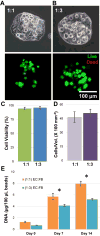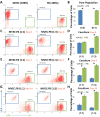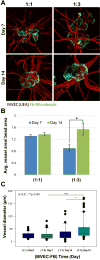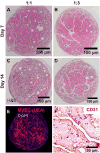Vascular Network Formation by Human Microvascular Endothelial Cells in Modular Fibrin Microtissues
- PMID: 29503863
- PMCID: PMC5830175
- DOI: 10.1021/acsbiomaterials.6b00274
Vascular Network Formation by Human Microvascular Endothelial Cells in Modular Fibrin Microtissues
Abstract
Microvascular endothelial cells (MVEC) are a preferred cell source for autologous revascularization strategies, since they can be harvested and propagated from small tissue biopsies. Biomaterials-based strategies for therapeutic delivery of cells are aimed at tailoring the cellular microenvironment to enhance the delivery, engraftment, and tissue-specific function of transplanted cells. In the present study, we investigated a modular tissue engineering approach to therapeutic revascularization using fibrin-based microtissues containing embedded human MVEC and human fibroblasts (FB). Microtissues were formed using a water-in-oil emulsion process that produced populations of spheroidal tissue modules with a diameter of 100-200 µm. The formation of MVEC sprouts within a fibrin matrix over 7 days in culture was dependent on the presence of FB, with the most robust sprouting occurring at a 1:3 MVEC:FB ratio. Cell viability in microtissues was high (>90%) and significant FB cell proliferation was observed over time in culture. Robust sprouting from microtissues was evident, with larger vessels developing over time and FB acting as pericyte-like cells by enveloping endothelial tubes. These neovessels were shown to form an interconnected vascular plexus over 14 days of culture when microtissues were embedded in a surrounding fibrin hydrogel. Vessel networks exhibited branching and inosculation of sprouts from adjacent microtissues, resulting in MVEC-lined capillaries with hollow lumens. Microtissues maintained in suspension culture aggregated to form larger tissue masses (1-2 mm in diameter) over 7 days. Vessels formed within microtissue aggregates at a 1:1 MVEC:FB ratio were small and diffuse, whereas the 1:3 MVEC:FB ratio produced large and highly interconnected vessels by day 14. This study highlights the utility of human MVEC as a cell source for revascularization strategies, and suggests that the ratio of endothelial to support cells can be used to tailor vessel characteristics. The modular microtissue format may allow minimally invasive delivery of populations of prevascularized microtissues for therapeutic applications.
Keywords: Modular tissue engineering; fibrin; fibrinogen; injectable scaffolds; microtissues; microvascular endothelial cells; minimally invasive delivery; vascularization.
Figures










Similar articles
-
Biofabrication of injectable fibrin microtissues for minimally-invasive therapies: application of surfactants.Biomed Mater. 2018 Apr 16;13(4):045005. doi: 10.1088/1748-605X/aab66f. Biomed Mater. 2018. PMID: 29536947 Free PMC article.
-
Endothelial sprouting and network formation in collagen- and fibrin-based modular microbeads.Acta Biomater. 2016 Jan;29:33-41. doi: 10.1016/j.actbio.2015.10.022. Epub 2015 Oct 23. Acta Biomater. 2016. PMID: 26481042 Free PMC article.
-
Vasculogenesis and Angiogenesis in Modular Collagen-Fibrin Microtissues.Biomater Sci. 2014 Oct 1;2(10):1497-1508. doi: 10.1039/C4BM00141A. Biomater Sci. 2014. PMID: 25177487 Free PMC article.
-
The Balance Between Metalloproteinases and TIMPs: Critical Regulator of Microvascular Endothelial Cell Function in Health and Disease.Prog Mol Biol Transl Sci. 2017;147:101-131. doi: 10.1016/bs.pmbts.2017.01.001. Epub 2017 Mar 27. Prog Mol Biol Transl Sci. 2017. PMID: 28413026 Review.
-
Scaffold-free microtissues: differences from monolayer cultures and their potential in bone tissue engineering.Clin Oral Investig. 2013 Jan;17(1):9-17. doi: 10.1007/s00784-012-0763-8. Epub 2012 Jun 14. Clin Oral Investig. 2013. PMID: 22695872 Free PMC article. Review.
Cited by
-
Soluble ECM promotes organotypic formation in lung alveolar model.Biomaterials. 2022 Apr;283:121464. doi: 10.1016/j.biomaterials.2022.121464. Epub 2022 Mar 16. Biomaterials. 2022. PMID: 35306229 Free PMC article.
-
Transport Analysis of Engineered Liver Tissue Fabricated Using a Capsule-Based, Modular Approach.Ann Biomed Eng. 2019 May;47(5):1223-1236. doi: 10.1007/s10439-018-02192-y. Epub 2019 Feb 22. Ann Biomed Eng. 2019. PMID: 30796550 Free PMC article.
-
Reseeding endothelial cells with fibroblasts to improve the re-endothelialization of pancreatic acellular scaffolds.J Mater Sci Mater Med. 2019 Jul 10;30(7):85. doi: 10.1007/s10856-019-6287-x. J Mater Sci Mater Med. 2019. PMID: 31292746
-
Differential roles of normal and lung cancer-associated fibroblasts in microvascular network formation.APL Bioeng. 2024 Mar 19;8(1):016120. doi: 10.1063/5.0188238. eCollection 2024 Mar. APL Bioeng. 2024. PMID: 38524671 Free PMC article.
-
Hydrogel degradation promotes angiogenic and regenerative potential of cell spheroids for wound healing.Mater Today Bio. 2023 Aug 11;22:100769. doi: 10.1016/j.mtbio.2023.100769. eCollection 2023 Oct. Mater Today Bio. 2023. PMID: 37636986 Free PMC article.
References
Grants and funding
LinkOut - more resources
Full Text Sources
Other Literature Sources
